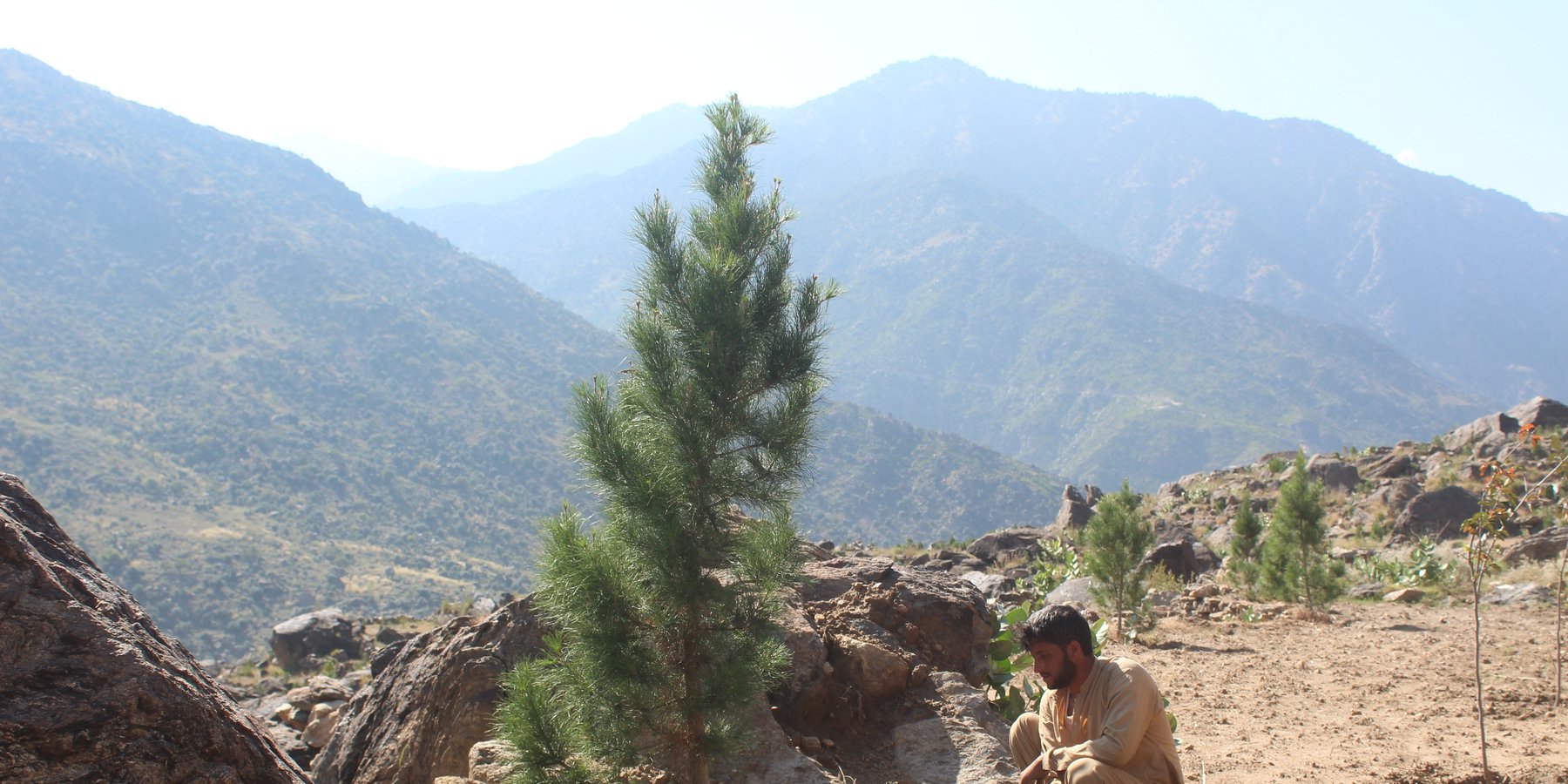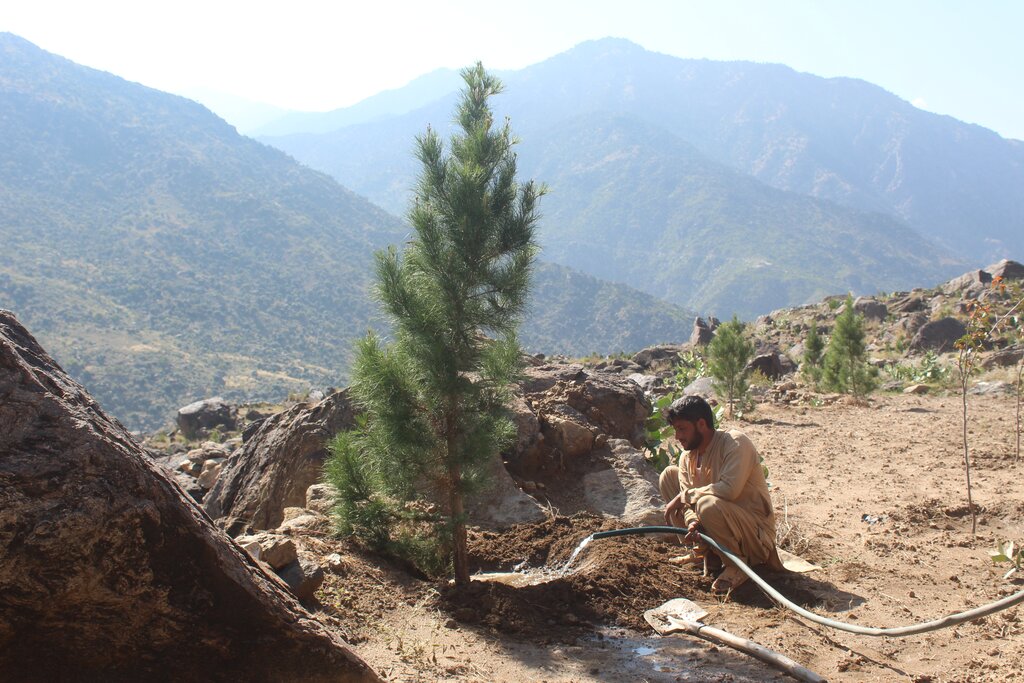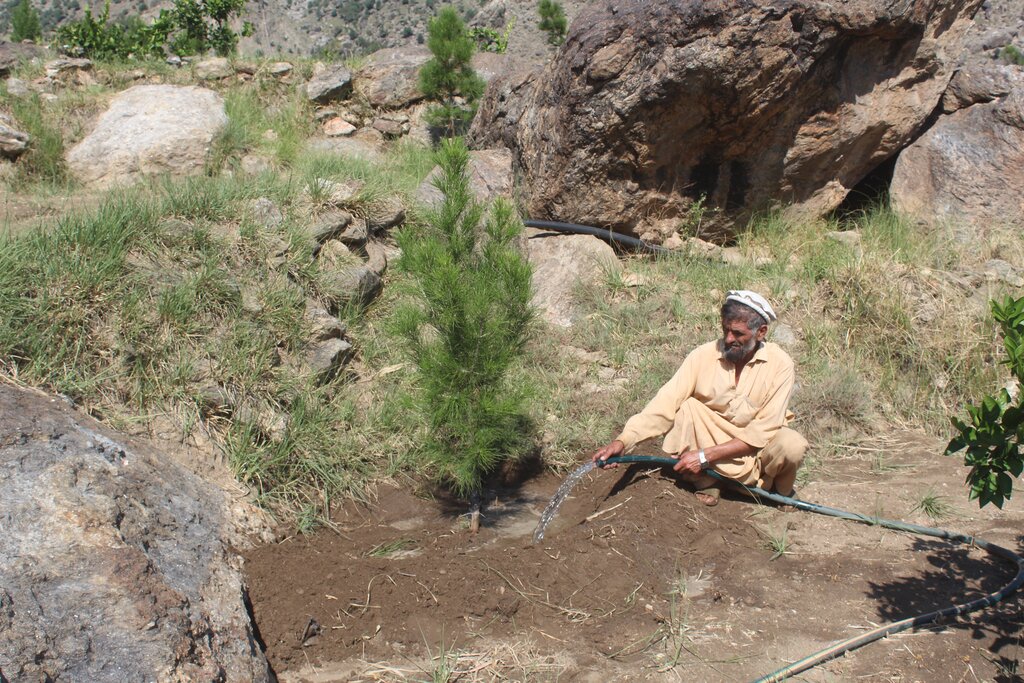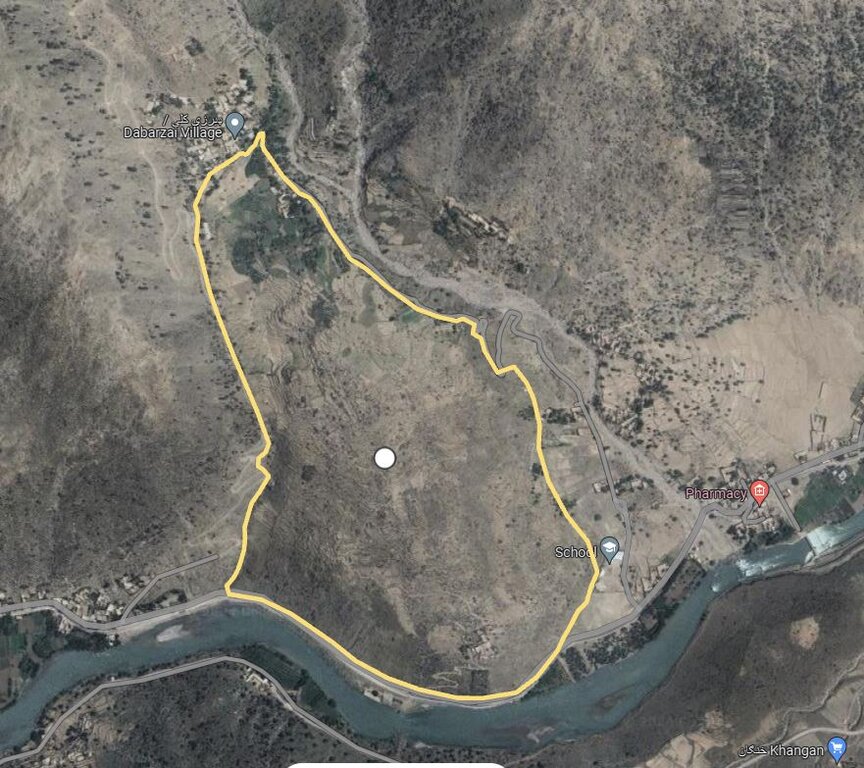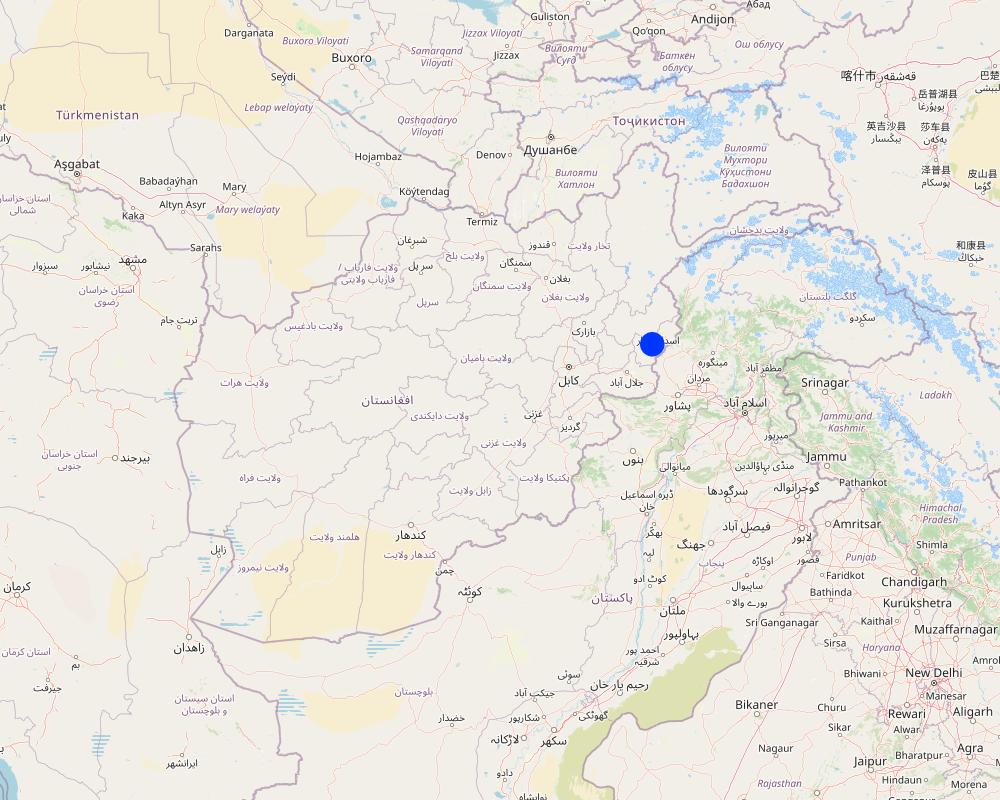Using lift irrigation for afforestation and agroforestry in Kunar [Афганистан]
- Создание:
- Обновить:
- Составитель: Ahmad Khalid Wiyar
- Редакторы: Megha bajaj, Mohammad Ajmal Rahimy, Mir Wali Khan Lakanwal
- Рецензенты: Rima Mekdaschi Studer, Illias Animon, Muhammad Ishaq Safi
د ځنګل رغونی او کرنیزی ځنګلداری لپاره د پمپ په واسطه د ابه خور سیستم
technologies_7473 - Афганистан
- Полная аннотация в формате PDF
- Полная аннотация в формате PDF для вывода на печать
- Полная аннотация в формате интернет-страницы
- Полная аннотация (неотформатированно)
- Using lift irrigation for afforestation and agroforestry in Kunar: 5 марта 2025 г. (inactive)
- Using lift irrigation for afforestation and agroforestry in Kunar: 24 марта 2025 г. (inactive)
- Using lift irrigation for afforestation and agroforestry in Kunar: 18 мая 2025 г. (inactive)
- Using lift irrigation for afforestation and agroforestry in Kunar: 9 июля 2025 г. (public)
Просмотреть разделы
Развернуть все Свернуть все1. Общая информация
1.2 Контактные данные специалистов и организаций, участвующих в описании и оценке Технологии
Ответственный (-ые) специалист (-ы)
Специалист по УЗП:
Safi Sharifullah
Food and Agriculture Organization of the United Nations
Афганистан
землепользователь:
Safi Mohammad Afzal
Managi Forest Management Association (FMA)
Афганистан
землепользователь:
Safi Qiamuddin
Managi Forest Management Association (FMA)
Афганистан
землепользователь:
Safi Farhad
Managi Forest Management Association (FMA)
Афганистан
Название проекта, содействовавшего документированию/оценке Технологии (если применимо)
Community-based sustainable land and forest management in AfghanistanНазвание организации (-ий), содействовавших документированию/оценке Технологии (если применимо)
FAO Afghanistan (FAO Afghanistan) - Афганистан1.3 Условия, регламентирующие использование данных, собранных ВОКАТ
Составитель и ответственный(-ые) специалист(-ы) согласны с условиями, регламентирующими использование собранных ВОКАТ данных:
Да
1.4 Декларация по устойчивости описываемой Технологии
Вызывает ли описанная здесь Технология проблемы деградации земель настолько, что ее нельзя назвать природосберегающей?
Нет
Пояснения:
No, the technology described here is not problematic with regard to land degradation. In fact, it promotes sustainable land management by enhancing soil health, preventing erosion, and supporting afforestation efforts. This technology contributes to the restoration and conservation of forest ecosystems.
2. Описание Технологии УЗП
2.1 Краткое описание Технологии
Определение Технологии:
Water exploitation is a major issue in Afghanistan. The lift irrigation technology helps to irrigate an afforestation/agroforestry area (demonstration plot) using surface water (rivers) and solar-powered submersible pump. The construction of reservoirs at the demo plot ensures efficient water storage and use for irrigation purposes without relying on groundwater. A well-designed pipe irrigation scheme is implemented to distribute water evenly across the site, supporting plant irrigation and growth.
2.2 Подробное описание Технологии
Описание:
Water exploitation is a critical issue in Afghanistan, and the project aims to address this challenge through innovative and sustainable technology. The technology involves the use of solar panels and submersible water pumps to efficiently lift water from a nearby river to reservoirs constructed uphill, which is then distributed by gravity with the help of a pipe system to irrigate planted saplings in the afforested and agroforestry area. For afforestation, Pinus eldarica (Afghan pine) was planted due to its adaptability and soil stabilization properties. Additionally, citrus and persimmon trees are introduced for agroforestry, combining tree cultivation with agricultural benefits. This integrated technology promotes biodiversity, soil health, and sustainable land use, making the site a model/ demonstration site for afforestation and agroforestry practices. This is a significant advancement in the local area, utilizing clean energy to promote sustainable land and forest management and environmental restoration. The project is implemented on communal land, covering 50.25 hectares of land.
The primary purpose of this technology is to create an efficient irrigation system that extracts and transports water to support afforestation and agroforestry activities. By doing so, it aims to restore forest cover, mitigate environmental challenges such as land degradation, and promote long-term ecological and socio-economic sustainability. The technology includes key components such as solar panels, water pumps (submersible), polyvinyl chloride (PVC) pipes, water reservoirs, and saplings. Additionally, it requires labor, technical assistance, capacity-building programs, and construction materials for its establishment and maintenance.
The benefits of this technology are substantial. It has successfully irrigated previously barren land, achieving an impressive 85% survival rate for the saplings that were planted in the plot, while preventing land degradation and improving soil health. Without this technology, survival rates would drop to zero due to the arid conditions. Furthermore, the project has enhanced the capacities of local farmers/community members, enabling them to replicate and demonstrate the technology within their community. This has fostered a sense of ownership and empowerment among land users.
Land users have expressed both appreciation and concerns regarding the technology. On the positive side, they value its efficiency and reliability, as the solar panels provide a consistent water supply, especially during the hot/sunny season, leading to increased greenery and healthier trees. The cost-effectiveness of solar energy, with its low operational costs compared to traditional diesel pumps, has also been a significant advantage. Additionally, the environmentally friendly nature of the technology aligns with their desire for sustainable practices. The capacity-building programs provided by organizations like FAO have further empowered users to manage the system effectively.
However, some challenges have been noted. The initial investment costs for purchasing, installing and construction of the technology are high, making it difficult for smallholder farmers to replicate. Technical issues, such as inverter failures or battery malfunctions during extreme weather conditions (e.g., cloudy weather), can disrupt operations. Additionally, not all community members are equally informed about the technology’s benefits, highlighting the need for increased outreach and engagement efforts to ensure broader adoption and understanding.
In summary, this solar-powered irrigation technology represents a groundbreaking innovation in the area, combining clean energy with sustainable land management practices. While it has demonstrated significant environmental and agricultural benefits, addressing the challenges of initial costs, technical reliability, and community engagement will be crucial for its long-term success and scalability.
2.3 Фотографии, иллюстрирующие Технологию
2.4 Видеоматериалы, иллюстрирующие Технологию
Место:
N/A
Автор съемки:
N/A
2.5 Страна/ регион/ места, где применяется Технология, информация о которых собрана в данной Анкете
Страна:
Афганистан
Административная единица (Район/Область):
Kunar
Более точная привязка места:
Managi village of Manogi district
Охарактеризуйте пространственное распространение Технологии :
- примененяется точечно/ на небольших участках
Технология применяется на ООПТ?
Нет
Пояснения:
The area is about 50.25 ha, and the coordinate has been taken from the center of the site, where technology has been implemented:
34.9419930°N71.0119714°E
Map
×2.6 Сколько лет применяется данная Технология
Год начала реализации:
2022
2.7 Внедрение Технологии
Укажите, как именно Технология УЗП была внедрена:
- через проекты/ внешнее вмешательство
Пояснения (тип проекта и т.д.):
GEF-06 Community based Sustainable Land and Forest Management in Afghanistan
3. Классификация Технологии УЗП
3.1 Основные цели и задачи реализации Технологии
- повышение производства
- снижение или предотвращение деградации земель, восстановление нарушенных земель
- адаптация к изменению климата / экстремальным погодным явлениям и их последствиям
- создание благоприятных экономических условий
3.2 Текущий(-ие) тип(-ы) землепользования на территории, где применяется Технология
Комбинированное землепользование в пределах одной и той же земельной единицы:
Да
Укажите сочетания типов землепользования (посевы / пастбища / деревья):
- Агролесоводство

Пахотные угодья и плантации
- Древесные и кустарниковые культуры
Древесные и кустарниковые культуры - Уточните культуры:
- цитрусовые
- Persimmon
Число урожаев за год:
- 1
Применяются ли посевы в междурядьях?
Нет
Применяется ли севооборот?
Нет

Леса/ лесистая местность
- Лесопосадки, облесение
Лесопосадки. облесение: Укажите происхождение и состав видов:
- Монокультуры местных видов деревьев
Тип лесонасаждений, облесение:
- субтропическая сухая лесная плантация - Pinus spp.
Вид деревьев:
- Вид сосны (сосна)
Являются ли указанные выше деревья лиственными или вечнозелеными?
- вечнозеленые
Продукции и услуги:
- Природоохранные/ защитные
- Рекреация/ туризм
- Защита от природных катаклизмов
3.3 Изменилось ли использование земель в связи с внедрением Технологии?
Изменилось ли использование земель в связи с внедрением Технологии?
- Да (Пожалуйста, заполните нижеприведенные вопросы относительно использования земель до внедрения Технологии)
Комбинированное землепользование в пределах одной и той же земельной единицы:
Нет
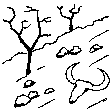
Непродуктивные земли
Поясните:
5 decades ago, the area was a forest area, but due to war, smuggling and drought the area become barren land.
3.4 Водоснабжение
Обеспеченность водой участков, где реализуется Технология :
- сочетание богарных и орошаемых земель
Пояснения:
The saplings planted in the area have been supplementary irrigated. Prior to the implementation of this technology, the land was barren, and seasonal rains led to soil erosion.
3.5 Категория УЗП, к которой относится Технология
- лесное хозяйство в лесопосадках
- Улучшение почвенного/ растительного покрова
- энергосберегающие технологии
3.6 Мероприятия УЗП, выполняемые в рамках Технологии

Мероприятия с использованием растительности
- Р1: Древесный и кустарниковый покров

инженерные мероприятия
- И5: Дамбы, водохранилища, пруды
- И7: Водосборное/ водопроводное/ оборудование для орошения
- И10: Энергосберегающие мероприятия

управленческие мероприятия
- У1: Смена типа землепользования
- У3: Размещение с учетом природных и социально-экономических условий
Пояснения:
The project has successfully implemented afforestation by planting trees and promoting agroforestry through the cultivation of fruit trees. To improve irrigation management, the project installed a 1-inch underground pipeline system with connected taps, enabling the attachment of flexible hoses. This efficient setup ensures optimal watering of saplings while significantly reducing water waste. By implementing this approach, the project has enhanced vegetative cover and successfully planted approximately 32,000 saplings. Additionally, the project constructed 14 rotating mounting structures for solar panels, installed 134 solar panels, established pipe schemes for manual irrigation of saplings, and constructed 6 water reservoirs with different capacities. The integration of trees at optimal spacing, combined with regular cultural practices, has further supported the project's goals.
3.7 Основные проблемы деградации земель, на решение которых направлена Технология

водная эрозия почв
- ВЭп: поверхностная эрозия/смыв верхних почвенных горизонтов

биологическая деградация
- Бр: сокращение растительного покрова
- Бм: утрата местообитаний
- Бф: утрата биологической составляющей почв

деградация водных ресурсов
- Ва: почвенная засуха
- Вуг: изменения уровня грунтовых вод/ водоносных горизонтов
Пояснения:
The planting pits are specially designed for planting of saplings. Additionally, farmers construct small barriers near plants (eye-brows and trenches), known as micro-catchments, to collect and retain water. It is important to note that these micro-catchments are distinct structures, separate from pits and reservoirs, and are specifically built to support water retention for plants. The enhanced vegetation cover and the establishment of micro-catchments for water collection significantly reduce soil erosion. Soil improvement and enrichment, as well as habitat enhancement, are supported through these practices. Additionally, they contribute to groundwater recharge and help control runoff.
3.8 Предотвращение и снижение деградации земель, или восстановление нарушенных земель
Укажите цель Технологии по отношению к деградации земель :
- предотвращение деградации земель
- восстановление/ реабилитация нарушенных земель
Пояснения:
The human-induced causes of land degradation include deforestation, overgrazing of livestock, and unsustainable agricultural practices. In response, following the implementation of a specific technology, local communities established regulations rooted in their customs and traditions to protect the site, which is quarantined for five years. These regulations prohibit herders from grazing animals, cutting trees, engaging in unsustainable agricultural practices, and uprooting bushes for fuelwood. Additionally, the community has constructed rainwater harvesting structures, such as eyebrows and trenches, across the site to address natural causes of land degradation through runoff by enhancing water infiltration. As a result, the site is now effectively protected from both human-induced and natural land degradation.
4. Технические характеристики, мероприятия по практической реализации, вложения и стоимость
4.1 Технический рисунок, иллюстрирующий Технологию
Спецификация (пояснения к техническому рисунку):
According to the technical specifications from the project engineer, 6 reservoirs have been constructed with varying dimensions and water holding capacities as follows:
1.First reservoir: Dimension of 12x6x2 meters, with a water holding capacity of 144 m³.
2.Central reservoir: Dimensions of 16x8x2 meters, with a water holding capacity of 256 m³.
3.Four additional reservoirs: Each measuring 10x5x2 meters, with a water holding capacity of 100 m³
In total, the reservoirs will hold 800 m³ of water, ensuring a reliable water supply for irrigation of the area. Two 2-inch submersible pumps draw water from the river to supply the first reservoir. From there, two additional 2-inch submersible pumps transfer water from the first reservoir to the central reservoir. The water then flows to the other four reservoirs by gravity.
Furthermore, excavation and backfilling for 2-inch polyethylene pipes should be done to a depth of 80 cm with a width of 50 cm. For 1.5-inch pipes, excavation and backfilling should be 40 cm deep. The installation of 1.5-inch polyethylene pipes, including all elbows, joints, connectors, and valves, should be carried out every 30 meters on both sides, connecting to 1-inch pipes, in accordance with specifications and to satisfaction.
Additionally, 32,000 Pinus eldarica (Afghan Pine) and 2,500 citrus and persimmon saplings were planted across 50.25 hectares of degraded land. The saplings are spaced 5 meters apart, both plant-to-plant and row-to-row, as part of afforestation and agroforestry initiatives. This effort aims to restore ecosystems, enhance biodiversity, and improve soil conservation.
Автор:
Hafizullah Naeemy
Дата:
01/03/2022
4.2 Общая информация по необходимым вложениям и стоимости
Уточните, как рассчитывались затраты и вложения:
- на площадь, где применяется Технология
Укажите размер и единицу площади:
50.25 Hectares
Укажите денежные единицы, использованные для подсчета затрат:
- Доллары США
Укажите среднюю дневную заработную плату наемных работников:
5 USD
4.3 Мероприятия, необходимые для начала реализации
| Деятельность | Время (сессия) | |
|---|---|---|
| 1. | Awareness and mobilization of the community | Aug-2021 |
| 2. | Survey and site selection followed by feasibility study | Sep to Oct-2021 |
| 3. | Stakeholder consultation | Aug-2021 till Sep-2022 |
| 4. | Preparation of technical design, drawings, and Bill of Quantities (BoQ). | Nov to Dec-2021 |
| 5. | Initiation of procurement process for required tools and equipment | Jan to Feb-2022 |
| 6. | Excavation and construction of water reservoirs, setting up pipe system and installation of solar panels for irrigation. | Mar to Sep-2022 |
| 7. | Capacity building of the target communities | Aug- 2021 till date |
| 8. | Practical interventions: production or purchase of saplings, digging planting pits, transplatation and irrigation of saplings and establishment of micro-catchments | Feb to Mar-2023 |
Пояснения:
The awareness-raising session on Sustainable Land Management (SLM) and Sustainable Forest Management (SFM) was successfully held to improve understanding of land and forest management practices and conservation efforts. Community members were actively mobilized to support the project, aiding in the completion of construction and installation work.
4.4 Вложения и затраты, необходимые для начала реализации
| Опишите затраты | Единица | Количество | Затраты на единицу | Общая стоимость на единицу | % затрат, оплаченных землепользователями | |
|---|---|---|---|---|---|---|
| Оплата труда | Unskilled labor for planting of saplings | Man/day | 450,0 | 5,0 | 2250,0 | 100,0 |
| Оплата труда | Skilled labor for installation of irrigation system and constuction of reservoirs | Man/day | 50,0 | 10,0 | 500,0 | |
| Оборудование | Water Pump 2 inch - 10HP/7500w | Number | 4,0 | 450,0 | 1800,0 | |
| Оборудование | Solar Panel minimum size 400W and 270W | Number | 132,0 | 82,0 | 10824,0 | |
| Оборудование | DC to AC Inverter 7.5-11KW | Number | 4,0 | 450,0 | 1800,0 | |
| Оборудование | Polyethylene Pipes 2 Inch and 1.5 Inch with all elbows, joints, connectors and valves after 30 meter for both sides to connect pipes. | Meter | 4300,0 | 2,75 | 11825,0 | |
| Оборудование | Rotating PV panels mounting structure (manual) | Number | 28,0 | 270,0 | 7560,0 | |
| Оборудование | DC and AC current wire | Meter | 1800,0 | 2,5 | 4500,0 | |
| Оборудование | Distribution board | Number | 2,0 | 70,0 | 140,0 | |
| Оборудование | Flexon 1 inch rubberize pipes | Meter | 5500,0 | 1,4 | 7700,0 | |
| Посадочный материал | Saplings procured & transported | Sapling | 32000,0 | 0,775 | 24800,0 | |
| Посадочный материал | Planting tools | lump sum | 1,0 | 500,0 | 500,0 | 100,0 |
| Удобрения и ядохимикаты | Organic fertilizers for transplanted saplings added through community | Kg | 16000,0 | 0,1 | 1600,0 | 100,0 |
| Строительные материалы | 6 reservoirs constructed by a construction company (cement, stone, sand excavation, etc.. | lump sum | 1,0 | 35000,0 | 35000,0 | |
| Другие | Patrolling, irrigating and quarantine of the site | lump sum | 1,0 | 1000,0 | 1000,0 | 100,0 |
| Общая стоимость запуска Технологии | 111799,0 | |||||
| Общие затраты на создание Технологии в долларах США | 111799,0 | |||||
Если землепользователем оплачено менее 100% затрат, укажите, кем покрывались остальные затраты:
The remining cost were covered by the project.
Пояснения:
The first two 2-inch submersible pumps draw water from the river to supply the first reservoir. From there, two additional 2-inch submersible pumps transfer water from the first reservoir to the central reservoir. The water then flows to the other four reservoirs through gravity.
4.5 Поддержание/ текущее обслуживание
| Деятельность | Сроки/ повторяемость проведения | |
|---|---|---|
| 1. | Cleaning of sedimentation of reservoirs | Spring/annually |
| 2. | Patrolling | All seasons/regular |
| 3. | Repairing solar system & water pump (submersible) | Ad hoc /Annually |
| 4. | Plot maintenance (Pest-diseases control, mulching, weeding,). | Spring & Automn/annually |
| 5. | Replacement of failed saplings | Feb/two times (1st & 2nd year) |
| 6. | Repairing micro-catchments | Spring/annually |
4.6 Стоимость поддержания/ текущего обслуживания ( в год)
| Опишите затраты | Единица | Количество | Затраты на единицу | Общая стоимость на единицу | % затрат, оплаченных землепользователями | |
|---|---|---|---|---|---|---|
| Оплата труда | Labor for cleaning of sedimentation of reservoirs | Man/day | 60,0 | 5,0 | 300,0 | 100,0 |
| Оплата труда | Labor for patrolling | Man/day | 360,0 | 5,0 | 1800,0 | 100,0 |
| Оплата труда | Labor for repairing micro-catchments | Man/day | 20,0 | 5,0 | 100,0 | 100,0 |
| Оплата труда | Manage the solar system operations | Man/day | 360,0 | 2,77 | 997,2 | 100,0 |
| Оплата труда | Labor for weeding and mulching | Man/day | 30,0 | 5,0 | 150,0 | 100,0 |
| Оборудование | Pump submersible, PVC pipe, fittings | lumpsum | 3,0 | 500,0 | 1500,0 | 100,0 |
| Оборудование | Shovels | lumpsum | 1,0 | 140,0 | 140,0 | 100,0 |
| Посадочный материал | saplings | Sapling | 2000,0 | 0,6 | 1200,0 | 100,0 |
| Удобрения и ядохимикаты | Organic fertilizers (cows dungs) | Kg | 16000,0 | 0,1 | 1600,0 | 100,0 |
| Общая стоимость поддержания Технологии | 7787,2 | |||||
| Общие затраты на поддержание Технологии в долларах США | 7787,2 | |||||
Пояснения:
The community has hired an individual to manage the solar system operations. This person is responsible for both operating the solar system for lifting water and overseeing the distribution of water for irrigation purposes among community members.
4.7 Наиболее значимые факторы, влияющие на стоимость затрат
Опишите наиболее значимые факторы, влияющие на стоимость затрат:
All equipment are imported and has resulted into higher cost.
Natural hazards, floods and windstorms will increase the costs of repairs and replacement
5. Природные и социально-экономические условия
5.1 Климат
Среднегодовое количество осадков
- < 250 мм
- 251-500 мм
- 501-750 мм
- 751-1000 мм
- 1001-1500 мм
- 1501-2000 мм
- 2001-3000 мм
- 3001-4000 мм
- > 4000 мм
Укажите среднегодовое количество осадков (если известно), мм:
300,00
Пояснения/ комментарии по осадкам:
Most of rain occur in the months of Feb, Mar, Apr, July and Aug.
Укажите название соответствующей метеостанции:
The data has been collected based on the farmers observation and local practices.
Агроклиматическая зона
- полузасушливая
5.2 Рельеф
Склоны (преобладающие):
- пологие (0-2%)
- покатые (3-5%)
- покато-крутые (6-10%)
- крутые (11-15%)
- очень крутые (16-30%)
- чрезвычайно крутые (31-60%)
- обрывистые (>60%)
Формы рельефа:
- плато/ равнины
- гребни хребтов/холмов
- склоны гор
- склоны холмов
- подножья
- днища долин
Зона высотной поясности:
- 0-100 м над уровнем моря
- 101-500 м н.у.м.
- 501-1000 м н.у.м.
- 1001-1500 м н.у.м.
- 1501-2000 м н.у.м.
- 2001-2500 м н.у.м.
- 2501-3000 м н.у.м.
- 3001-4000 м н.у.м.
- > 4 тыс. м н.у.м.
Укажите, приурочено ли применение Технологии к специфическим условиям:
- в ситуациях вогнутого рельефа
5.3 Почвы
Средняя мощность почв:
- поверхностные (0-20 см)
- неглубокие (21-50 см)
- умеренно глубокие (51-80 см)
- глубокие (81-120 см)
- очень глубокие (> 120 см)
Гранулометрический состав (верхнего горизонта):
- средние фракции (суглинистый, супесчаный)
Гранулометрический состав (на глубине более 20 см):
- средние фракции (суглинистый, супесчаный)
Содержание органического вещества в верхнем горизонте:
- низкое (< 1%)
5.4 Доступность и качество воды
Уровень грунтовых вод:
> 50 м
Доступность поверхностных вод:
средняя
Качество воды (без обработки):
питьевая вода хорошего качества
Качество воды относится к:
одновременно грунтовые и поверхностные воды
Является ли солёность воды проблемой?
Нет
Происходят ли периодические затопления территории?
Да
Регулярность:
часто
5.5 Биоразнообразие
Видовое разнообразие:
- средняя
Разнообразие местообитаний:
- средняя
5.6 Характеристика землепользователей, применяющих Технологию
Осёдлый или кочевой:
- Осёдлый
Рыночная ориентация производства:
- смешанный (натуральный / коммерческий)
Доходы из других источников:
- < 10% всех доходов
Относительный уровень достатка:
- плохой
Индивидуальное или коллективное хозяйство:
- группа/ община
Уровень механизации:
- ручной труд
Пол:
- мужчины
Возраст землепользователей:
- средний возраст
5.7 Средняя площадь земель, используемых землепользователями с применением Технологии
- < 0,5 га
- 0,5-1 га
- 1-2 га
- 2-5 га
- 5-15 га
- 15-50 га
- 50-100 га
- 100-500 га
- 500-1000 га
- 1000-10000 га
- > 10000 га
Считается ли это мелким, средним или крупным хозяйством (по местным масштабам)?
- мелкое
Пояснения:
The area where the technology is applied covers 50.25 hectares and is managed by 112 land users.
5.8 Собственность на землю, права на земле- и водопользование
Землевладелец:
- общинная/ поселковая
- индивидуальная, оформленная в собственность
Право землепользования:
- общинное (контролируемое)
- индивидуальное
Право водопользования:
- общинное (контролируемое)
- индивидуальное
Права на землепользование основаны на традиционной правовой системе?
Да
Поясните:
In Afghanistan, the traditional land use system involves the equitable distribution of deserts and barren land among the local residents. The decisions made by the elders are respected and adhered to by all members of the community.
5.9 Доступ к базовым услугам и инфраструктуре
медицинское обслуживание:
- плохой
- средний
- хорошая
образование:
- плохой
- средний
- хорошая
технические консультации:
- плохой
- средний
- хорошая
занятость (вне хозяйства):
- плохой
- средний
- хорошая
рынки:
- плохой
- средний
- хорошая
электроснабжение:
- плохой
- средний
- хорошая
транспорт и дорожная сеть:
- плохой
- средний
- хорошая
водоснабжение и канализация:
- плохой
- средний
- хорошая
финансовые услуги:
- плохой
- средний
- хорошая
6. Воздействия и заключительные положения
6.1 Влияние Технологии УЗП в пределах территории ее применения
Социально-экономическое воздействие
Продуктивность
производство сельскозяйственных культур
Количество до применения УЗП :
0
Количество после применения УЗП:
fruit production (citrus and persimmon)
Комментарий/ пояснения:
The 2500 citrus and persimmon saplings have been planted as part of the agroforestry system and will bear fruit in line with the demand and needs of the people. Based on the production, the socio-economic status of the community members is expected to improve.
производство древесины
Количество до применения УЗП :
0
Количество после применения УЗП:
A total of 32,000 forest saplings (Pinus species) were successfully planted
Комментарий/ пояснения:
32,000 Pinus eldarica (Afghani pine) and 2,500 citrus and persimmon saplings have been planted across 50.25 hectares of degraded land. Following agronomic practices, the four Ds—dead, diseased, damaged, and dying—branches will be pruned and utilized for shelter and fuel.
площадь, используемая для производства продукции
Количество до применения УЗП :
0 fruit trees
Количество после применения УЗП:
Approximately 1,200 fruit trees, including sweet orange and persimmon species, have been planted
Комментарий/ пояснения:
The 2500 citrus and persimmon saplings have been planted as a agroforestry and will bear fruit in line with the demand and needs of the people.
управление землями
Комментарий/ пояснения:
The area was once barren and occasionally used for rainfed cultivation, where most farmers grew wheat. Now, with the introduction and implementation of the technology farmers can also intercrop beans, mung beans, and others. Farmers who have more than 1 hectare of land hire labor for agronomical practices.
Доступность и качество воды
доступность оросительных вод
Количество до применения УЗП :
0
Количество после применения УЗП:
100%
Комментарий/ пояснения:
With the adoption of this technology, irrigation for planted saplings is now available 100% throughout all seasons of the year.
Доходы и затраты
разнообразие источников дохода
Комментарий/ пояснения:
Timber Production, Non-Timber Forest Products, Ecotourism, Agroforestry, Wildlife Conservation and Fuelwood and Biomass
Социальное и культурное воздействие
возможности отдыха и рекреации
Комментарий/ пояснения:
Recreational opportunities that benefit both local communities and visitors such as nature trails allowed individuals to engage with nature, promoting physical activity and wellness. The reforestation efforts have led to the restoration of habitats for various wildlife species, this provides opportunities for wildlife observation and photography, and contributing to local ecotourism.
знания в области УЗП/ деградации земель
Комментарий/ пояснения:
Improved due to workshops and on job trainings
Экологическое воздействие
Водный цикл/ поверхностный сток
поверхностный сток
Комментарий/ пояснения:
Due to better soil coverage by plantation of saplings and micro-catchment structures
Почвы
влажность почв
Комментарий/ пояснения:
Due to the availability of irrigation water and the establishment of micro-catchments to harvest water and enhance water infiltaration soil moisture for sapling growth has increased
почвенный покров
Комментарий/ пояснения:
Due to natural regeneration and plantation of saplings and intercrops
утрата почв
Комментарий/ пояснения:
Due to better soil coverage and less water runoff
Биоразнообразие: растительность, животный мир
Растительный покров
биомасса/ содержание углерода в надземной биомассе
разнообразие флоры
Климат и снижение риска стихийных бедствий
последствия наводнений
Комментарий/ пояснения:
better soil cover reduced water runoff and ultimately flooding
6.2 Влияние Технологии за пределами территории ее применения
ущерб объектам инфраструктуры общего/ частного пользования
Комментарий/ пояснения:
Soil erosion was reduced and has been better controlled
воздействие парниковых газов
Комментарий/ пояснения:
Due to plantation
6.3 Подверженность и чувствительность Технологии УЗП к постепенным изменениям климата и экстремальным погодным явлениям/ стихийным бедствиям, связанным с изменением климата (в понимании землепользователей)
Постепенное изменение климата
Постепенное изменение климата
| Сезон | увеличение или уменьшение | Насколько успешно Технология справляется с этим? | |
|---|---|---|---|
| среднегодовые температуры | увеличилось | умеренно | |
| среднегодовое количество осадков | увеличилось | умеренно | |
| сезонное количество осадков | весна | увеличилось | умеренно |
Экстремальные явления, связанные с изменением климата (стихийные бедствия)
Погодные стихийные бедствия
| Насколько успешно Технология справляется с этим? | |
|---|---|
| местные ураганы | умеренно |
6.4 Анализ эффективности затрат
Насколько получаемый результат сопоставим с первоначальными вложениями (с точки зрения землепользователей)?
Эффективность затрат в краткосрочной перспективе:
слабо позитивное
Эффективность затрат в долгосрочной перспективе:
очень позитивное
Насколько получаемый результат сопоставим с текущими расходами по поддержанию технологии (с точки зрения землепользователей)?
Эффективность затрат в краткосрочной перспективе:
слабо позитивное
Эффективность затрат в долгосрочной перспективе:
очень позитивное
6.5 Внедрение Технологии
- 1-10%
Среди применяющих Технологию землепользователей, какова доля лиц, применяющих её по собственной инициативе, т.е. без какого-либо материального стимулирования со стороны?
- 0-10%
Пояснения:
The community economic condition is not good. So, without receiving incentives they are not able to adopt such technology easily.
6.6 Адаптация
Была ли Технология УЗП изменена в недавнее время с целью адаптации к меняющимся условиям среды?
Нет
6.7 Сильные стороны/ преимущества/ возможности Технологии
| Сильные стороны/ преимущества/ возможности по мнению землепользователей |
|---|
| Improved water availability with minimized fuel cost and decreased pollution as well as minimum operational cost |
| Opportunities/ potential for upscaling of the technology |
| Use of clean energy to contribute to mitigate climate change |
| Reduce greenhouse emission through carbon sequestration |
| Сильные стороны/ преимущества/ возможности по мнению составителя или других ключевых специалистов |
|---|
| The technology is highly efficient and suitable for adoption by land users. It promotes clean energy, reduces greenhouse gas emissions through carbon sequestration, and contributes to climate change adaptation. |
| The area has been successfully afforested, restoring its natural beauty and original landscape. |
| The vegetation cover on the previously degraded land has been significantly enhanced. |
| This technology with its approach for implementation represents an effective solution for the restoration of degraded soils. |
6.8 Слабые стороны/ недостатки/ риски Технологии и пути их преодоления
| Слабые стороны/ недостатки/ риски по мнению землепользователей | Возможные пути их преодоления/снижения? |
|---|---|
| Inadequate maintenance and repair services of the technology | Linkage to the service provider and maintenance services. Nation wide technology transfer |
| Solar water lifting relies on fully sunny days for operation, which can sometimes be a limitation, especially when weather conditions are cloudy or during periods of low sunlight. This can result in insufficient water being lifted to meet the irrigation needs of the site. | Backup charging system/battery system |
| Слабые стороны/ недостатки/ риски по мнению составителя или ответственных специалистов | Возможные пути их преодоления/снижения? |
|---|---|
| Solar water lifting depends on sunny days for operation, which can sometimes fall short of meeting irrigation needs during cloudy periods. | Combining solar power with backup energy (like batteries or grid connection) |
7. Справочные материалы и ссылки
7.1 Методы сбора/ источники информации
- выезды на места, полевые обследования
10
- опросы землепользователей
15
- опросы специалистов/экспертов по УЗП
2
Когда были собраны данные (на местах)?
28/11/2024
Пояснения:
The data has been collected during Oct and Nov 2024
Ссылки и модули
Развернуть все Свернуть всеСсылки
Нет ссылок
Модули
Нет модулей


